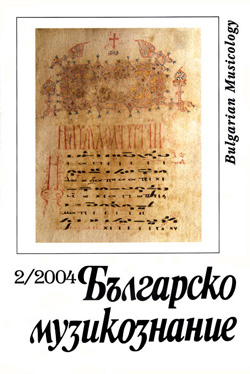Историческо проследяване на дяла echemata (των ήχημάτων) във византийските музикални трактати по извори от XII до XVI в.
Historical tracing of echemata section (των ήχημάτων) in Yanko Marinov byzantine musical treatises based on sources dated between XII-XVI century
Author(s): Stanislava Georgiava, Yanko MarinovSubject(s): Music
Published by: Институт за изследване на изкуствата, Българска академия на науките
Summary/Abstract: The heritage of Byzantine musical treatises known as προπαιδεία and προθεωρία is a valuable source of information about neumatic notation and its use in ecclesiastical chants. The present work deals with the section of intonation formulas (echemata) and its close relation with the liturgical practice. Usually, this section follows others which represent the names, graphic symbols and combinations of the neumes, their classification in groups and the exposition of the modes, modal signatures and modulation signs φθοραί. We find some clarification of the meaning of the mysterious words used for singing the intonation formulas (without literal translation) - αvαvεαvες, ανεαvες, αvεσ, αγια etc. in Greek-Arabic music treatise Petrop. Gr. 497 identified by Yanko Marinov as a part of Sinai Hirmologion 1257 (1332) and in the treatise of Chrysantos. The wide space dedicated to echemata section in some of the byzantine musical treatises is indicative of their important role in liturgical practice during the Middle Ages. Analysis of the various kinds of intonation formulas (intonations) and comparison between them take up a large place in this study and every detail of theirs is important because they witness the regional characteristics. The echemata variants of four modes (first, second, third and forth plagal) are classified in several groups each of them including intonations that have identical (similar) melodic constructions or endings. Two types of exposition in the echemata sections are being distinguished here: an early type, in which the intonations are few in number and they are given mostly in their short forms and a late type including numerous additional variants some of them combined with the incipits of certain stichera. Also the number of the intonations containing melismatic figures increases in the late treatises . We find melismatic variants even in the earliest sections of echemata, a fact that makes us conclude about the simultaneous existence of short and melismatic intonations before their inscription in treatises. The study is based on eight byzantine manuscripts dated between XII-XVI century. (The list of sources and their abbreviations is given on page 5). Sticherarion 1218 does not contain a full treatise. In it we can find the earliest systematic exposition of the intonation formulas (f. 271) according to the known up to now sources. Even though the treatise Petrop. Gr. 495 contains no colophon, however it could be dated according to Sticherarion Sin. gr.1231 (1236). In terms of the date of the Vatican anthology Barb. gr. 300, we accept the thesis of E.Gamillscheg, D. Harlfinger and H. Hunger. A part of the present publication also deals with the problem of close relation between intonation formulas and modal signatures; a subject on which efforts have been made in a lot of studies to enlighten us. O.Strunk’s thesis that the signatures are a simple abbreviation of the intonation formulas presumes the secondary character of
Journal: Българско музикознание
- Issue Year: 2004
- Issue No: 2
- Page Range: 27-55
- Page Count: 29
- Content File-PDF

